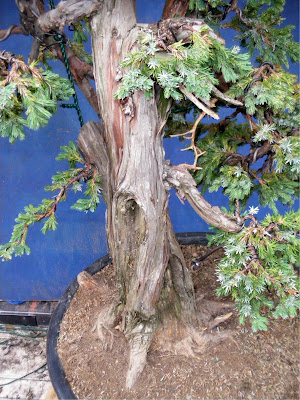Bei einem Besuch in einem großen Gartencenter in den Niederlanden sah ich doch tatsächlich inmitten vieler anderer Chinamassenbonsaiware einen kleinen, schnukkeligen Maulbeerbaum. Der Preis lag inclusive dieser völlig innovativen Bonsaischale nebst Untersetzer bei 5 €. Diese Species stand schon seid langer Zeit auf meiner "Liste" und bei einem solchen Angebot konnte ich nicht - Nein - sagen ;-). Vielleicht haben die Gärtner in den Niederlanden den Blattfall falsch interprtiert ... die Knospenanlagen dieses Maulbeerbaumes sind gut ausgebildet und nach dem Umsetzen in Lava zeigen sich bereits schon nach wenigen Tagen Knospenschwellungen und der Morus wird sicher in Kürze wunderbar sein neues Laub entwickeln. Dieser Morus wird sicher in einigen Jahren ein kleiner , netter Shohin werden ... und er hilft mir jetzt gut über diese weihnachtliche Ruhe ;-)
Nevertheless, during a visit in a big garden centre in the Netherlands I really saw in the midst of a lot of other China- mass- bonsai products a small Morus alba tree. The price was inclusive of this "absolutely innovative bonsai bowl" together with coaster 5€. These Species stood already a long time on my "list" and with such an offer I could not say - no-;-). Maybe the gardeners have interpreted the leave fall of this Morustree wrong ... the bud arrangements are well trained and they are on the way of sprouting out and while moving in lavasoil already after a few days buds swells and the Morus new foliage will develop certainly shortly wonderfully. This Morus will unite certainly in a small period of time to a nice Shohin ... and he well helps me about this Christmassy rest ;-)Sin embargo, durante una visita en un centro de jardinería grande en hollanda realmente vi en medio de la mayor parte de otra China - masa - productos de bonsai un pequeño Morus alba árbol. El precio era global de este "plato hondo de bonsai absolutamente innovador" juntos con el barco de cabotaje 5€. Estas especies pusieron ya mucho tiempo a mi "lista" y con tal oferta yo no podía decir - no-;-). Tal vez los jardineros han interpretado la caída de permiso de este mal Morusarbol... los arreglos de brote son bien entrenados y ellos están en el modo de brotar y moviéndose a lavasoil ya después de oleajes de brotes de unos días y el nuevo follaje Morus se desarrollará seguramente dentro de poco maravillosamente. Este Morus se unirá seguramente en un pequeño período de tiempo a Shohin agradable... y él bien me ayuda sobre este resto de dias de navidad ;-)






























































